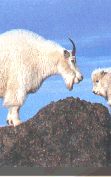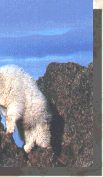


![]()
![]()



Description
The mountain goat is an even-toed ungulate in common with wapiti, deer and moose. He is hollow-horned as is the pronghorn and belongs to the same sub-family as the muskox and the mountain sheep. He appears as three sub-species in British Columbia and his Latin or scientific name is Oreamnos americanus. Technically, he might be best described as a goat-antelope, for he is not a true goat. In fact, his closest relative is the chamois of the Alps.
Appearance
The mountain goat is a blunt squarish-looking animal with a rather short body and humped shoulders. The narrow head has a black muzzle, sharp pointed ears and a double beard of long hair on the chin and throat. The white coat has a soft, woolly, three to four inches thick undercoat. Long coarse guard hairs, up to seven inches long, form heavy mats over the shoulders and hips giving a humped appearance. The coat grows to within eight inches of each hoof, where it abruptly stops giving the appearance of the goat wearing pataloons, As the days become longer and the weather warmer, they begin to shed their heavy winter coat. By the end of July, the short summer coat has often turned a yellow color. Black hooves also give accent to the white coat and are equipped with cushioned skid-proof pads for grip and traction on steep rocky surfaces.
Horns
The slender, black shiny horns rise in a smooth backward curve to a length of ten to twelve inches. The record length was from a female goat whose horns measured 12-4/8 inches. The tip to tip spread is usuaIly about ten inches. Horns are not shed each year and develop annual growth rings which indicate the age of the animal.
Distribution
Present distribution in Canada covers parts of Alberta, Yukon Territory and British Columbia. B.C.'s population of aproximately 120,000 is by far the largest of any of the US states or Canadian provinces.
Feeding Habits
Nourishment taken by this animal is quite varied ranging from alpine grasses and flowers to almost any tree and shrub except spruce. In winter they subsist on a minimum of food browsing species such as frozen shrubs with a little dried grass exposed by shifting winds and snow. Food eaten is digested in typical ruminant style. The leaves are first ripped off by the animal running his tongue across the lower, sharp-edged front incisor teeth, after which the forage is partially chewed and swallowed. When the mountain goat rests, small pellets called cuds are returned to the mouth to be completely milled.
Habitat
Mountain goats inhabit the roughest possible terrain in the mountain ranges, usually remaining at or above timberline and within easy reach of rocky bluffs for hasty retreat from any danger. They may travel short distances through forests and valleys but will seldom linger there.
The Rut
Mating activity reaches a peak between November and early December, after pre-mating activities such as forming into groups, slashing brush with their horns and digging of rut beds by the adult males. A scent gland behind the horn produces an oil which is left as a marker for other goats. Duning the rut some combat takes place between mature males as they try to maintain the company of receptive females. Occasionally, casualities will occur and serious wounds are inflicted when the usual fast rushes of mock battle are replaced by more intensive fighting.
Back to Mountain Goat Hunting
BOWHUNTING Canada ®
PO Box 649, Lundar, MB R0C-1Y0, Canada
(204) 762-6133